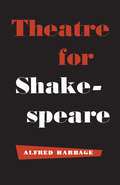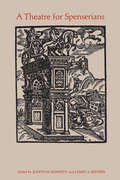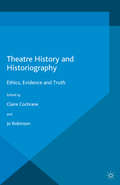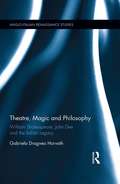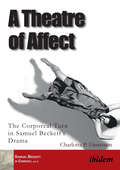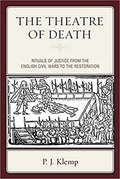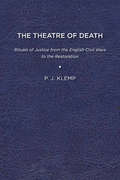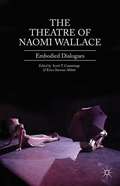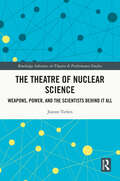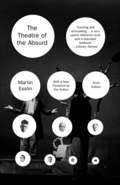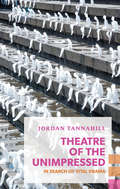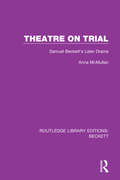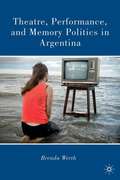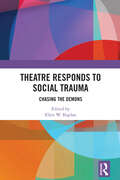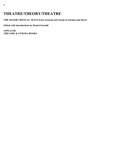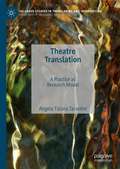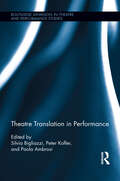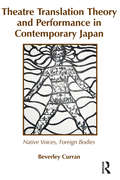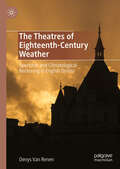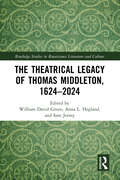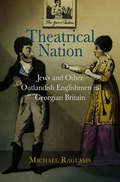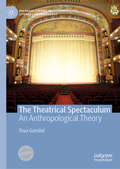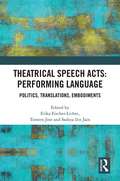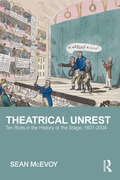- Table View
- List View
Theatre for Shakespeare
by Alfred HarbageHere is a book to hearten playgoers, stimulate young actors, lead theatrical executives to reconsider methods of management, and encourage benefactors to open their wallets. In this new book (containing the Alexander Lectures for 1954-55), Mr. Harbage, distinguished critic and scholar, advocates a movement to give Shakespeare back to the audiences. He complains that, in greater or less degree, Shakespearean audiences are in constant danger of being bored, or more precisely of being "reverently unreceptive," of being gratified that they have come to the play and gratified that they then may go. In his opinion there is no theatre in the world today that can present Shakespeare with full adequacy. Mr. Harbage feels that Shakespearean production is at present lacking in a sense of direction, and needs some form of exemplary leadership. Counsels of perfection are required. There should be at least one company to set a standard, one not dependent upon immediate financial success, and one committed only to realizing artistic ideals worthy of the plays. The wholesome tendency to return to the original methods of production for guidance would be more effectual if a distinction were made between what is still applicable in those original methods and what is not. The author's argument is provocative and amusing throughout; it begins with detailed complaints and ends with detailed remedies. A generous amount of information about Elizabethan precedents and traditions is included. Alfred Harbage has published numerous books which have become cornerstones in Shakespearean scholarship: Annals of English Drama, 975-1700; Shakespeare's Audience; As They Liked It; and Shakespeare and the Rival Traditions. He has prepared new editions of The Tempest and As You Like it, is General Editor of the American Pelican Shakespeare, had published articles in learned journals, and has held editorial and advisory posts.
A Theatre for Spenserians: Papers of the International Spencer Colloquium Fredericton, New Brunswick October 1969
by Judith Kennedy James ReitherThe International Spenser Colloquium, sponsored by St Thomas University and the University of New Brunswick, was held in Fredericton in 1969 to celebrate the four hundredth anniversary of Spenser's first appearance in print in A Theatre for Wordlings. The intention of the colloquium was to honour a great poet for the pleasure and profit his work continues to give and to promote understanding of his poetry through lectures, discussions, and proposals for future lines of exploration. The six original essays on Spenser's poetry contained in this volume were first presented at the colloquium. While there is a central concern with The Faerie Queene, the essays range widely through Spenser's works and treat many aspects of his poetic vision and artistry: his comic vein and his melancholy, his learning and his realism, his grand designs and his richness of detail. In their variety and vivacity the essays amply demonstrate the powerful appeal that Spenser's poetry exerts today and the quality of response it elicits
Theatre History and Historiography: Ethics, Evidence and Truth (Methuen Drama Handbooks Ser.)
by Claire CochraneThis collection of essays explores how historians of theatre apply ethical thinking to the attempt to truthfully represent their subject - whether that be the life of a well-known performer, or the little known history of colonial theatre in India - by exploring the process by which such histories are written, and the challenges they raise.
Theatre, Magic and Philosophy: William Shakespeare, John Dee and the Italian Legacy (Anglo-Italian Renaissance Studies)
by Gabriela Dragnea HorvathAnalyzing Shakespeare's views on theatre and magic and John Dee's concerns with philosophy and magic in the light of the Italian version of philosophia perennis (mainly Marsilio Ficino, Pico della Mirandola and Giordano Bruno), this book offers a new perspective on the Italian-English cultural dialogue at the Renaissance and its contribution to intellectual history. In an interdisciplinary and intercultural approach, it investigates the structural commonalities of theatre and magic as contiguous to the foundational concepts of perennial philosophy, and explores the idea that the Italian thinkers informed not only natural philosophy and experimentation in England, but also Shakespeare's theatre. The first full length project to consider Shakespeare and John Dee in juxtaposition, this study brings textual and contextual evidence that Gonzalo, an honest old Counsellor in The Tempest, is a plausible theatrical representation of John Dee. At the same time, it places John Dee in the tradition of the philosophia perennis-accounting for what appears to the modern scholar the conflicting nature of his faith and his scientific mind, his powerful fantasy and his need for order and rigor-and clarifies Edward Kelly's role and creative participation in the scrying sessions, regarding him as co-author of the dramatic episodes reported in Dee's spiritual diaries. Finally, it connects the Enochian/Angelic language to the myth of the Adamic language at the core of Italian philosophy and brings evidence that the Enochian is an artificial language originated by applying creatively the analytical instruments of text hermeneutics used in the Cabala.
A Theatre of Affect: The Corporeal Turn in Samuel Beckett's Drama (Samuel Beckett in Company #3)
by Charlotta P. EinarssonCombining phenomenological analysis with dance and performance analysis and affect theory, A Theatre of Affect: The Corporeal Turn in Samuel Beckett's Drama takes stock of the various ways in which the body in Samuel Beckett's drama participates in the affective ecology of performance. Affect is here located in the materiality of the body and discussed in relation to the symbolic significance of, for instance, the effort, direction, speed, or duration of a posture, movement, or gesture. Although the meaning of the body in Beckett's stage-images cannot be mapped onto conventional discursive meanings, the significance of the body's formal modulations is affective in the sense that the import of such changes is immediately recognized and felt as significant by spectators. Beckett's theater of affect therefore is predicated on the infinitesimal stirrings of subliminal meaning-making that continuously shape and create the world in experience.
The Theatre of Death: Rituals of Justice from the English Civil Wars to the Restoration (G - Reference, Information And Interdisciplinary Subjects Ser.)
by P J KlempThis book discusses some rituals of justice—such as public executions, printed responses to the Archbishop of Canterbury’s execution speech, and King Charles I’s treason trial—in early modern England. Focusing on the ways in which genres shape these events’ multiple voices, I analyze the rituals’ genres and the diverse perspectives from which we must understand them. The execution ritual, like such cultural forms as plays and films, is a collaborative production that can be understood only, and only incompletely, by being alert to the presence of its many participants and their contributions. Each of these participants brings a voice to the execution ritual, whether it is the judge and jury or the victim, executioner, sheriff and other authorities, spiritual counselors, printer, or spectators and readers. And each has at least one role to play. No matter how powerful some institutions and individuals may appear, none has a monopoly over authority and how the events take shape on and beyond the scaffold. The centerpiece of the mid-seventeenth-century’s theatre of death was the condemned man’s last dying utterance. This study focuses on the words and contexts of many of those final speeches, including King Charles I’s (1649), Archbishop William Laud’s (1645), and the Earl of Strafford’s (1641), as well as those of less well known royalists and regicides. Where we situate ourselves to view, hear, and comprehend a public execution—through specific participants’ eyes, ears, and minds or accounts—shapes our interpretation of the ritual. It is impossible to achieve a singular, carefully indoctrinated meaning of an event as complex as a state-sponsored public execution. Along with the variety of voices and meanings, the nature and purpose of the rituals of justice maintain a significant amount of consistency in a number of eras and cultural contexts. Whether the focus is on the trial and execution of the Marian martyrs, English royalists in the 1640s and 1650s, or the Restoration’s regicides, the events draw on a set of cultural expectations or conventions. Because rituals of justice are shaped by diverse voices and agendas, with the participants’ scripts and counterscripts converging and colliding, they are dramatic moments conveying profound meanings. Published by University of Delaware Press. Distributed worldwide by Rutgers University Press.
The Theatre of Death: Rituals of Justice from the English Civil Wars to the Restoration (G - Reference, Information And Interdisciplinary Subjects Ser.)
by P J KlempThis book discusses some rituals of justice—such as public executions, printed responses to the Archbishop of Canterbury’s execution speech, and King Charles I’s treason trial—in early modern England. Focusing on the ways in which genres shape these events’ multiple voices, I analyze the rituals’ genres and the diverse perspectives from which we must understand them. The execution ritual, like such cultural forms as plays and films, is a collaborative production that can be understood only, and only incompletely, by being alert to the presence of its many participants and their contributions. Each of these participants brings a voice to the execution ritual, whether it is the judge and jury or the victim, executioner, sheriff and other authorities, spiritual counselors, printer, or spectators and readers. And each has at least one role to play. No matter how powerful some institutions and individuals may appear, none has a monopoly over authority and how the events take shape on and beyond the scaffold. The centerpiece of the mid-seventeenth-century’s theatre of death was the condemned man’s last dying utterance. This study focuses on the words and contexts of many of those final speeches, including King Charles I’s (1649), Archbishop William Laud’s (1645), and the Earl of Strafford’s (1641), as well as those of less well known royalists and regicides. Where we situate ourselves to view, hear, and comprehend a public execution—through specific participants’ eyes, ears, and minds or accounts—shapes our interpretation of the ritual. It is impossible to achieve a singular, carefully indoctrinated meaning of an event as complex as a state-sponsored public execution. Along with the variety of voices and meanings, the nature and purpose of the rituals of justice maintain a significant amount of consistency in a number of eras and cultural contexts. Whether the focus is on the trial and execution of the Marian martyrs, English royalists in the 1640s and 1650s, or the Restoration’s regicides, the events draw on a set of cultural expectations or conventions. Because rituals of justice are shaped by diverse voices and agendas, with the participants’ scripts and counterscripts converging and colliding, they are dramatic moments conveying profound meanings. Published by University of Delaware Press. Distributed worldwide by Rutgers University Press.
The Theatre Of Naomi Wallace
by Scott T. Cummings Erica Stevens AbbittNaomi Wallace, an American playwright based in Britain, is one of the more original and provocative voices in contemporary theatre. Her poetic, erotically-charged, and politically engaged plays have been seen in London's West End, off-Broadway, at the Com#65533;die-Fran#65533;aise, in regional and provincial theaters, and on college campuses around the world. Known for their intimate, sensual encounters examining the relationship between identity and power, Wallace's works have attracted a wide range of theatre practitioners, including such important directors as Dominic Dromgoole, Ron Daniels, Jo Bonney, and Kwame Kwei-Armah. Drawing on scholars, activists, historians, and theatre artists in the United States, Canada, Britain, and the Middle East, this anthology of essays presents a comprehensive overview of Wallace's body of work that will be of use to theatre practitioners, students, scholars, and educators alike.
The Theatre of Nuclear Science: Weapons, Power, and the Scientists Behind it All (Routledge Advances in Theatre & Performance Studies)
by Jeanne P TiehenThe Theatre of Nuclear Science theoretically explores theatrical representations of nuclear science to reconsider a science that can have consequences beyond imagination. Focusing on a series of nuclear science plays that span the twentieth and twenty-first centuries, and including performances of nuclear science in museums, film, and media, Jeanne Tiehen argues why theatre and its unique qualities can offer important perspectives on this imperative topic. This book will be of great interest to students and scholars of theatre, politics, and literature.
The Theatre of the Absurd
by Martin EsslinIn 1953, Samuel Beckett’sWaiting for Godotpremiered at a tiny avant-garde theatre in Paris; within five years, it had been translated into more than twenty languages and seen by more than a million spectators. Its startling popularity marked the emergence of a new type of theatre whose proponents—Beckett, Ionesco, Genet, Pinter, and others—shattered dramatic conventions and paid scant attention to psychological realism, while highlighting their characters’ inability to understand one another. In 1961, Martin Esslin gave a name to the phenomenon in his groundbreaking study of these playwrights who dramatized the absurdity at the core of the human condition. Over four decades after its initial publication, Esslin’s landmark book has lost none of its freshness. The questions these dramatists raise about the struggle for meaning in a purposeless world are still as incisive and necessary today as they were when Beckett’s tramps first waited beneath a dying tree on a lonely country road for a mysterious benefactor who would never show. Authoritative, engaging, and eminently readable,The Theatre of the Absurdis nothing short of a classic: vital reading for anyone with an interest in the theatre.
Theatre of the Unimpressed
by Jordan TannahillA lot of plays are bad. And one bad play, it seems, can turn us off theater for good. So, what can we learn from the bad play? Jordan Tannahill, after talking to theater heavy-hitters from Australia to Berlin, offers a roadmap for a renewed theater, one that is less insular, less insulting, with better infrastructure. In reconsidering dramaturgy, programming strategies, and alternative models for producing, he aims to turn theater from an obligation to a destination.Jordan Tannahill is a multidisciplinary artist based in Toronto. His production of Sheila Heti's All Our Happy Days Are Stupid will be performed in New York in 2015.
Theatre of the Unimpressed
by Jordan TannahillHow dull plays are killing theatre and what we can do about it. Had I become disenchanted with the form I had once fallen so madly in love with as a pubescent, pimple-faced suburban homo with braces? Maybe theatre was like an all-consuming high school infatuation that now, ten years later, I saw as the closeted balding guy with a beer gut he'd become. There were of course those rare moments of transcendence that kept me coming back. But why did they come so few and far between? A lot of plays are dull. And one dull play, it seems, can turn us off theatre for good. Playwright and theatre director Jordan Tannahill takes in the spectrum of English-language drama - from the flashiest of Broadway spectacles to productions mounted in scrappy storefront theatres - to consider where lifeless plays come from and why they persist. Having travelled the globe talking to theatre artists, critics, passionate patrons and the theatrically disillusioned, Tannahill addresses what he considers the culture of 'risk aversion' paralyzing the form. Theatre of the Unimpressed is Tannahill's wry and revelatory personal reckoning with the discipline he's dedicated his life to, and a roadmap for a vital twenty-first-century theatre - one that apprehends the value of 'liveness' in our mediated age and the necessity for artistic risk and its attendant failures. In considering dramaturgy, programming and alternative models for producing, Tannahill aims to turn theatre from an obligation to a destination. '[Tannahill is] the poster child of a new generation of (theatre? film? dance?) artists for whom "interdisciplinary" is not a buzzword, but a way of life.'- J. Kelly Nestruck, The Globe and Mail 'Jordan is one of the most talented and exciting playwrights in the country, and he will be a force to be reckoned with for years to come.'- Nicolas Billon, Governor General's Award-winning playwright (Fault Lines)
Theatre on Trial: Samuel Beckett's Later Drama (Routledge Library Editions: Beckett #5)
by Anna McMullanThis book, first published in 1993, is the first full-length analysis of Samuel Beckett’s later drama in the context of contemporary critical and performance theory. It employs a close, textual examination of the later plays as a springboard for exploring ideas around authority, gender and the ideology of performance. Recent work in the world of critical theory has suggested new ways of looking at performance practice. McMullan argues that, while contemporary theory can deepen our understanding of Beckett’s dramatic practice, his drama places performance in the context of a metaphysical history and a metatheatrical tradition, thereby confronting and provoking some of the central debates in performance studies’ engagement with critical theory.
Theatre, Performance, and Memory Politics in Argentinay
by Brenda WerthSince Argentina's transition to democracy, the expression of human fragility on the stage has taken diverse forms. This book examines the intervention of theatre and performance in the memory politics surrounding Argentina's return to democracy and makes a case for performance's transformative power.
Theatre Responds to Social Trauma: Chasing the Demons (Routledge Series in Equity, Diversity, and Inclusion in Theatre and Performance)
by Ellen W. KaplanThis book is a collection of chapters by playwrights, directors, devisers, scholars, and educators whose praxis involves representing, theorizing, and performing social trauma.Chapters explore how psychic catastrophes and ruptures are often embedded in social systems of oppression and forged in zones of conflict within and across national borders. Through multiple lenses and diverse approaches, the authors examine the connections between collective trauma, social identity, and personal struggle. We look at the generational transmission of trauma, socially induced pathologies, and societal re-inscriptions of trauma, from mass incarceration to war-induced psychoses, from gendered violence through racist practices. Collective trauma may shape, protect, and preserve group identity, promoting a sense of cohesion and meaning, even as it shakes individuals through pain. Engaging with communities under significant stress through artistic practice offers a path towards reconstructing the meaning(s) of social trauma, making sense of the past, understanding the present, and re-visioning the future.The chapters combine theoretical and practical work, exploring the conceptual foundations and the artists’ processes as they interrogate the intersections of personal grief and communal mourning, through drama, poetry, and embodied performance.
Theatre/Theory/Theatre: The Major Critical Texts From Aristotle and Zeami to Soyinka and Havel (Applause Books)
by Daniel GerouldFrom Aristotle's Poetics to Vaclav Havel, the debate about the nature and function of theatre has been marked by controversy. Daniel Gerould's landmark work, Theatre/Theory/Theatre, collects history's most influential Eastern and Western dramatic theorists—poets, playwrights, directors and philosophers—whose ideas about theatre continue to shape its future. <p><p>In complete texts and choice excerpts spanning centuries, we see an ongoing dialogue and exchange of ideas between actors and directors like Craig and Meyerhold, and writers such as Nietzsche and Yeats. Each of Gerould's introductory essays shows fascinating insight into both the life and the theory of the author. From Horace to Soyinka, Corneille to Brecht, this is an indispensable compendium of the greatest dramatic theory ever written.
Theatre Translation: A Practice as Research Model (Palgrave Studies in Translating and Interpreting)
by Angela Tiziana TarantiniThis book examines the effects of translation on theatrical performance. The author adapts and applies Kershaw et al.’s Practice as Research model to an empirical investigation analysing the effects of translation on the rhythm and gesture of a playtext in performance, using the contemporary plays Convincing Ground and The Gully by Australian playwright David Mence which have been translated into Italian. The book is divided into two parts: a theoretical exegesis encompassing Translation Studies, Performance Studies and Gesture Studies, and a practical investigation comprising of a workshop where excerpts of the plays are explored by two groups of actors. The chapters are accompanied by short clips of the performance workshop hosted on SpringerLink. The book will be of interest to students and scholars in the fields of Translation Studies (and Theatre Translation more specifically), Theatre and Performance, and Gesture Studies.
Theatre Translation in Performance (Routledge Advances in Theatre & Performance Studies #29)
by Silvia Bigliazzi Peter Kofler Paola AmbrosiThis volume focuses on the highly debated topic of theatrical translation, one brought on by a renewed interest in the idea of performance and translation as a cooperative effort on the part of the translator, the director, and the actors. Exploring the role and function of the translator as co-subject of the performance, it addresses current issues concerning the role of the translator for the stage, as opposed to the one for the editorial market, within a multifarious cultural context. The current debate has shown a growing tendency to downplay and challenge the notion of translational accuracy in favor of a recreational and post-dramatic attitude, underlying the role of the director and playwright instead. This book discusses the delicate balance between translating and directing from an intercultural, semiotic, aesthetic, and interlingual perspective, taking a critical stance on approaches that belittle translation for the theatre or equate it to an editorial practice focused on literality. Chapters emphasize the idea of dramatic translation as a particular and extremely challenging type of performance, while consistently exploring its various textual, intertextual, intertranslational, contextual, cultural, and intercultural facets. The notion of performance is applied to textual interpretation as performance, interlingual versus intersemiotic performance, and (inter)cultural performance in the adaptation of translated texts for the stage, providing a wide-ranging discussion from an international group of contributors, directors, and translators.
Theatre Translation Theory and Performance in Contemporary Japan: Native Voices Foreign Bodies
by Beverley CurranWhat motivates a Japanese translator and theatre company to translate and perform a play about racial discrimination in the American South? What happens to a 'gay' play when it is staged in a country where the performance of gender is a theatrical tradition? What are the politics of First Nations or Aboriginal theatre in Japanese translation and 'colour blind' casting? Is a Canadian nô drama that tells a story of the Japanese diaspora a performance in cultural appropriation or dramatic innovation? In looking for answers to these questions, Theatre Translation Theory and Performance in Contemporary Japan extends discussions of theatre translation through a selective investigation of six Western plays, translated and staged in Japan since the 1960s, with marginalized tongues and bodies at their core. The study begins with an examination of James Baldwin's Blues for Mister Charlie, followed by explorations of Michel Marc Bouchard's Les feluettes ou La repetition d'un drame romantique, Tomson Highway's The Rez Sisters and Dry Lips Oughta Move to Kapuskasing, Roger Bennett's Up the Ladder, and Daphne Marlatt's The Gull: The Steveston t Noh Project. Native Voices, Foreign Bodies locates theatre translation theory and practice in Japan in the post-war Showa and Heisei eras and provokes reconsideration of Western notions about the complex interaction of tongues and bodies in translation and theatre when they travel and are reconstituted under different cultural conditions.
The Theatres of Eighteenth-Century Weather: Spectacle and Climatological Reckoning in English Drama
by Denys Van RenenWhile British drama of the long eighteenth century remains largely unexamined as registering ecological fears, its visual spectacle and settings allow the audience to grasp threats to environments across the globe. In plays from 1682-1799, The Theatres of Eighteenth-Century Weather: Spectacle and Climatological Reckoning in English Drama examines how the “little world” of the theatre enables the British to conceptualize and experience how scientific and technological innovations, industrialization, imperial enterprises, and the increasing scale and reach of the British military affect the climate. In fact, the book attributes the drama of Aphra Behn, Susanna Centlivre, Joseph Addison, Nahum Tate, Richard Brinsley Sheridan, and other playwrights as pivotal to maintaining an audience’s discernment of climatological processes and variability.
The Theatrical Legacy of Thomas Middleton, 1624–2024 (Routledge Studies in Renaissance Literature and Culture)
by William David Green Anna L. Hegland Sam JermyThis volume celebrates Thomas Middleton’s legacy as a dramatist, marking the 400th anniversary of Middleton’s final and most contentious work for the public theatres, A Game at Chess (1624).The collection is divided into three sections: ‘Critical and Textual Reception’, ‘Afterlives and Legacies’, and ‘Practice and Performance’. This division reflects the book’s holistic approach to Middleton’s canon, and its emphasis on the continuing significance of Middleton’s writing to the study of early modern English drama. Each section offers an assessment of the place of Middleton’s drama in culture, criticism, and education today through a range of critical approaches.Featuring work from a range of voices (from early career, independent, and seasoned academics and practitioners), the collection will be appropriate for both specialists in early modern literature and drama who are interested in both theory and practice, and students or scholars researching Middleton’s historical significance to the study of early theatre.
Theatrical Nation
by Michael RagussisPerhaps the most significant development of the Georgian theater was its multiplication of ethnic, colonial, and provincial character types parading across the stage. In Theatrical Nation, Michael Ragussis opens up an archive of neglected plays and performances to examine how this flood of domestic and colonial others showcased England in general and London in particular as the center of an increasingly complex and culturally mixed nation and empire, and in this way illuminated the shifting identity of a newly configured Great Britain.In asking what kinds of ideological work these ethnic figures performed and what forms were invented to accomplish this work, Ragussis concentrates on the most popular of the "outlandish Englishmen," the stage Jew, Scot, and Irishman. Theatrical Nation understands these stage figures in the context of the government's controversial attempts to merge different ethnic and national groups through the 1707 Act of Union with Scotland, the Jewish Naturalization Bill of 1753, and the Act of Union with Ireland of 1800.Exploring the significant theatrical innovations that illuminate the central anxieties shared by playhouse and nation, Ragussis considers how ethnic identity was theatricalized, even as it moved from stage to print. By the early nineteenth century, Anglo-Irish and Scottish novelists attempted to deconstruct the theater's ethnic stereotypes while reimagining the theatricality of interactions between English and ethnic characters. An important shift took place as the novel's cross-ethnic love plot replaced the stage's caricatured male stereotypes with the beautiful ethnic heroine pursued by an English hero.
The Theatrical Spectaculum: An Anthropological Theory (Palgrave Studies in Literary Anthropology)
by Tova GamlielThis book offers a new mythic perspective on the secret of the allure and survival of a current-archaic institution—the Western theatre—in an era of diverse technological media. Central to the theory is the spectaculum—a stage “world” that mirrors a monotheistic cosmic order. Tova Gamliel here not only alerts the reader to the possibility of the spectaculum’s existence, but also illuminates its various structural dimensions: the cosmological, ritual, and sociological. Its cosmo-logical meaning is a Judeo-Christian monotheistic consciousness of non-randomness, an exemplary order of the world that the senses perceive. The ritual meaning denotes the centrality of the spectaculum, as the theatre repeatedly reenacts the mythical and paradigmatic event of Biblical revelation. Its social meaning concerns any charismatic social theory that is anchored in the epitomic structure of social sovereignty—stage and audience—that the Western theatre advances in an era characterized by hypermedia.
Theatrical Speech Acts: Politics, Translations, Embodiments
by Erika Fischer-Lichte Torsten Jost Saskya Iris JainTheatrical Speech Acts: Performing Language explores the significance and impact of words in performance, probing how language functions in theatrical scenarios, what it can achieve under particular conditions, and what kinds of problems may arise as a result. Presenting case studies from around the globe—spanning Argentina, Egypt, Germany, India, Indonesia, Korea, Kenya, Nigeria, Rwanda, Thailand, the UK and the US—the authors explore key issues related to theatrical speech acts, such as (post)colonial language politics; histories, practices and theories of translation for/in performance; as well as practices and processes of embodiment. With scholars from different cultural and disciplinary backgrounds examining theatrical speech acts—their preconditions, their cultural and bodily dimensions as well as their manifold political effects—the book introduces readers to a crucial linguistic dimension of historical and contemporary processes of interweaving performance cultures. Ideal for drama, theater, performance, and translation scholars worldwide, Theatrical Speech Acts opens up a unique perspective on the transformative power of language in performance.
Theatrical Unrest: Ten Riots in the History of the Stage, 1601-2004
by Sean McEvoyShortlisted for the 2017 Theatre Book Prize What is it about theatre, compared to other kinds of cultural representation, which provokes such a powerful reaction? Theatrical Unrest tells the compelling tales of ten riots whose cause lies on stage. It looks at the intensity and evanescence of the live event and asks whether theatre shares its unrepeatable quality with history. Tracing episodes of unrest in theatrical history from an Elizabethan uprising over Shakespeare's Richard II to Sikhs in revolt at Gurpreet Kaur Bhatti's Behzti, Sean McEvoy chronicles a selection of extreme public responses to this inflammatory art form. Each chapter provides a useful overview of the structure and documentation of one particular event, juxtaposing eyewitness accounts with newspaper reports and other contemporary narratives. Theatrical Unrest is an absorbing account of the explosive impact of performance, and an essential read for anyone interested in theatre’s often violent history.
